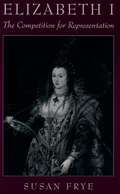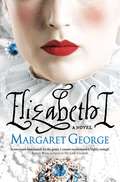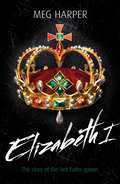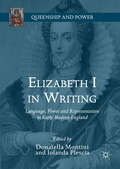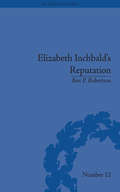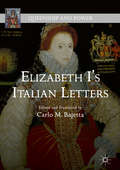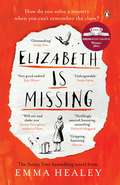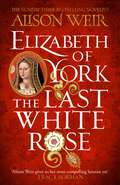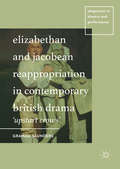- Table View
- List View
Elizabeth I: Translations, 1544-1589
by Elizabeth IEngland’s Virgin Queen, Elizabeth Tudor, had a reputation for proficiency in foreign languages, repeatedly demonstrated in multilingual exchanges with foreign emissaries at court and in the extemporized Latin she spoke on formal visits to Cambridge and Oxford. But the supreme proof of her mastery of other tongues is the sizable body of translations she made over the course of her lifetime. This two-volume set is the first complete collection of Elizabeth’s translations from and into Latin, French, and Italian. Presenting original and modernized spellings in a facing-page format, these two volumes will answer the call to make all of Elizabeth’s writings available. They include her renderings of epistles of Cicero and Seneca, religious writings of John Calvin and Marguerite de Navarre, and Horace’s Ars poetica, as well as Elizabeth’s Latin Sententiae drawn from diverse sources, on the responsibilities of sovereign rule and her own perspectives on the monarchy. Editors Janel Mueller and Joshua Scodel offer introduction to each of the translated selections, describing the source text, its cultural significance, and the historical context in which Elizabeth translated it. Their annotations identify obscure meanings, biblical and classical references, and Elizabeth’s actual or apparent deviations from her sources. The translations collected here trace Elizabeth’s steady progression from youthful evangelical piety to more mature reflections on morality, royal responsibility, public and private forms of grief, and the right way to rule. Elizabeth I: Translations is the queen’s personal legacy, an example of the very best that a humanist education can bring to the conduct of sovereign rule.
Elizabeth I: The Competition for Representation
by Susan FryeElizabeth I is perhaps the most visible woman in early modern Europe, yet little attention has been paid to what she said about the difficulties of constructing her power in a patriarchal society. This revisionist study examines her struggle for authority through the representation of her female body. Based on a variety of extant historical and literary materials, Frye's interpretation focuses on three representational crises spaced fifteen years apart: the London coronation of 1559, the Kenilworth entertainments of 1575, and the publication of The Faerie Queene in 1590. In ways which varied with social class and historical circumstance, the London merchants, the members of the Protestant faction, courtly artists, and artful courtiers all sought to stabilize their own gendered identities by constructing the queen within the "natural" definitions of the feminine as passive and weak. Elizabeth fought back, acting as a discursive agent by crossing, and thus disrupting, these definitions. She and those closely identified with her interests evolved a number of strategies through which to express her political control in terms of the ownership of her body, including her elaborate iconography and a mythic biography upon which most accounts of Elizabeth's life have been based. The more authoritative her image became, the more vigorously it was contested in a process which this study examines and consciously perpetuates.
Elizabeth I: The Competition for Representation
by Susan FryeElizabeth I is perhaps the most visible woman in early modern Europe, yet little attention has been paid to what she said about the difficulties of constructing her power in a patriarchal society. This revisionist study examines her struggle for authority through the representation of her female body. Based on a variety of extant historical and literary materials, Frye's interpretation focuses on three representational crises spaced fifteen years apart: the London coronation of 1559, the Kenilworth entertainments of 1575, and the publication of The Faerie Queene in 1590. In ways which varied with social class and historical circumstance, the London merchants, the members of the Protestant faction, courtly artists, and artful courtiers all sought to stabilize their own gendered identities by constructing the queen within the "natural" definitions of the feminine as passive and weak. Elizabeth fought back, acting as a discursive agent by crossing, and thus disrupting, these definitions. She and those closely identified with her interests evolved a number of strategies through which to express her political control in terms of the ownership of her body, including her elaborate iconography and a mythic biography upon which most accounts of Elizabeth's life have been based. The more authoritative her image became, the more vigorously it was contested in a process which this study examines and consciously perpetuates.
Elizabeth I (Bride Series)
by Margaret George1588. In the height of her power is the legendary Elizabeth Tudor, history's most enigmatic queen. She is the virgin with many suitors; the victor of the Armada who hated war; the jewel-bedecked woman always pinching pennies. Elizabeth's flame-haired cousin, Lettice Knollys, is her bitter rival. In love with Robert Dudley, Earl of Leicester, and mother to the Earl of Essex, the mercurial nobleman who challenged Elizabeth's throne, Lettice has been intertwined with Elizabeth since childhood. This is a story of two women of fierce intellect and desire: one trying to protect her country and throne; the other trying to regain power and position for her family. Their rivalry soon involves everyone close to Elizabeth – from the famed courtiers who enriched the crown to the legendary poets and playwrights. And, for Elizabeth, to be married to her people meant she must rule as much with her heart as with her head . . .
Elizabeth I: The Story of the Last Tudor Queen (Lives in Action)
by Meg HarperThe story of Elizabeth I, thelast Tudor monarch, is one of enduring fascination. Daughter of thetyrannical Henry VIII and sister of the embittered Queen Mary,Elizabeth did well to survive her childhood. Clever, learned andskilled in diplomacy, as queen she presided over a golden age ofliterature, exploration and discovery. A selectiveversion of events from Elizabeth's life focuses on her younger years,without distorting thepicture of a reign dominated by war, political intrigue and religiousdisputes.Lives in Action is a series ofnarrative biographies that recount the lives of some of the key figuresin history. Page-turning, thrilling plots that read like fiction willkeep the most reluctant reader hooked.
Elizabeth I in Writing
by Donatella Montini Iolanda PlesciaThis collection investigates Queen Elizabeth I as an accomplished writer in her own right as well as the subject of authors who celebrated her. With innovative essays from Brenda M. Hosington, Carole Levin, and other established and emerging experts, it reappraises Elizabeth’s translations, letters, poems and prayers through a diverse range of approaches to textuality, from linguistic and philological to literary and cultural-historical. The book also considers Elizabeth as “authored,” studying how she is reflected in the writing of her contemporaries and reconstructing a wider web of relations between the public and private use of language in early modern culture. Contributions from Carlo M. Bajetta, Guillaume Coatelen and Giovanni Iamartino bring the Queen’s presence in early modern Italian literary culture to the fore. Together, these essays illuminate the Queen in writing, from the multifaceted linguistic and rhetorical strategies that she employed, to the texts inspired by her power and charisma.
The Elizabeth Icon: 1603–2003
by J. WalkerSurveying four-hundred years of British history, Walker examines how the memory - the icon - of Queen Elizabeth has been used as a marker for Englishness in disputes political and social, in art, literature and popular culture. From her second Westminster tomb to the pseudo-secret histories of the Restoration, from Georgian ballads to Victorian paintings, biographies, children's books, Suffragette banners, novels and films, trends in scholarship and rubber bath ducks, the icon becomes more powerful as the idea of Englishness becomes more arbitrary.
Elizabeth Inchbald's Reputation: A Publishing and Reception History (The History of the Book)
by Ben P RobertsonThrough an examination of her complete works and public response to them, Robertson gauges the extent of Inchbald's reputation as the dignified Mrs Inchbald, as well as providing a clear sense of what it meant to be a female Romantic writer.
Elizabeth Inchbald's Reputation: A Publishing and Reception History (The History of the Book #12)
by Ben P RobertsonThrough an examination of her complete works and public response to them, Robertson gauges the extent of Inchbald's reputation as the dignified Mrs Inchbald, as well as providing a clear sense of what it meant to be a female Romantic writer.
Elizabeth I's Italian Letters (Queenship and Power)
by Carlo M. BajettaThis is the first edition ever of the Queen’s correspondence in Italian. These letters cast a new light on her talents as a linguist and provide interesting details as to her political agenda, and on the cultural milieu of her court. This book provides a fresh analysis of the surviving evidence concerning Elizabeth’s learning and use of Italian, and of the activity of the members of her ‘Foreign Office.’ All of the documents transcribed here are accompanied by a short introduction focusing on their content and context, a brief description of their transmission history, and an English translation.
Elizabeth is Missing
by Emma HealeySunday Times Bestseller Elizabeth is Missing is the stunning, smash-hit debut novel from new author Emma HealeyWinner of the Costa First Novel Award 2014Shortlisted for the National Book Awards Popular Fiction Book 2014Shortlisted for the National Book Awards New Writer of the Year 2014Longlisted for the Baileys Women's Prize for Fiction 2015Longlisted for the Dylan Thomas Prize 2014'A thrillingly assured, haunting and unsettling novel, I read it at a gulp' Deborah Moggach, author of The Best Exotic Marigold Hotel'Elizabeth Is Missing will stir and shake you: the most likeably unreliable of narrators, real mystery at its compassionate core...' Emma Donoghue, author of Room 'Resembling a version of Memento written by Alan Bennett' Daily Telegraph'One of those mythical beasts, the book you cannot put down' Jonathan Coe, author of The Rotters Club'Every bit as compelling as the frenzied hype suggests. Gripping, haunting' Observer'If you're after a read you can't put down, then look no further' New!Meet Maud.Maud is forgetful. She makes a cup of tea and doesn't remember to drink it. She goes to the shops and forgets why she went. Sometimes her home is unrecognizable - or her daughter Helen seems a total stranger.But there's one thing Maud is sure of: her friend Elizabeth is missing. The note in her pocket tells her so. And no matter who tells her to stop going on about it, to leave it alone, to shut up, Maud will get to the bottom of it.Because somewhere in Maud's damaged mind lies the answer to an unsolved seventy-year-old mystery. One everyone has forgotten about. Everyone, except Maud . . .
Elizabeth of York: Tudor Rose Novel 1
by Alison WeirThe captivating new Tudor novel from Alison Weir, Sunday Times bestselling author of Six Tudor Queens.'Alison Weir gives us her most compelling heroine yet... This is where the story of the Tudors begins' Tracy Borman'History has the best stories and they should all be told like this' Conn Iggulden'A stunning read, and the perfect piece of historical fiction' Reader review ⭐ ⭐⭐ ⭐⭐'This novel captured my imagination, educated me and emotionally moved me' Reader review ⭐ ⭐⭐ ⭐⭐---A princess born into a war between two families...Firstborn of the royal House of York, Elizabeth dreams of wearing a crown. But in England, queens do not rule.When her beloved father, King Edward, dies suddenly, his brother seizes power. Two young princes disappear into the Tower. Yet another claimant seeks the crown, the upstart heir of the rival House of Lancaster. Marriage to this Henry Tudor would unite their warring families - and help Elizabeth to the throne she knows is hers by right.A glorious new age awaits. Now Elizabeth must choose her allies wisely as she fights to become mother and queen of a great new dynasty.Elizabeth of York.The first Tudor queen.Her story.---READERS FELL IN LOVE WITH ELIZABETH OF YORK...'I found her an inspirational woman, full of strength...I truly adored this book''She becomes the matriarch of the Tudor destiny after a series of intrigue, conflict, and most likely murder... a brilliant read''Alison Weir's writing just makes history that bit more exciting and accessible''It was refreshing to read such a detailed and informative book of an almost forgotten Queen''An amazing read as expected from Alison Weir, she breathes life into Elizabeth and those around her'
Elizabeth Singer Rowe and the Development of the English Novel
by Paula R. BackscheiderElizabeth Singer Rowe and the Development of the English Novel is the first in-depth study of Rowe’s prose fiction. A four-volume collection of her work was a bestseller for a hundred years after its publication, but today Rowe is a largely unrecognized figure in the history of the novel. Although her poetry was appreciated by poets such as Alexander Pope for its metrical craftsmanship, beauty, and imagery, by the time of her death in 1737 she was better known for her fiction. According to Paula R. Backscheider, Rowe's major focus in her novels was on creating characters who were seeking a harmonious, contented life, often in the face of considerable social pressure. This quest would become the plotline in a large number of works in the second half of the eighteenth century, and it continues to be a major theme today in novels by women.Backscheider relates Rowe’s work to popular fiction written by earlier writers as well as by her contemporaries. Rowe had a lasting influence on major movements, including the politeness (or gentility) movement, the reading revolution, and the Bluestocking society. The author reveals new information about each of these movements, and Elizabeth Singer Rowe emerges as an important innovator. Her influence resulted in new types of novel writing, philosophies, and lifestyles for women. Backscheider looks to archival materials, literary analysis, biographical evidence, and a configuration of cultural and feminist theories to prove her groundbreaking argument.
Elizabeth Singer Rowe and the Development of the English Novel
by Paula R. BackscheiderElizabeth Singer Rowe and the Development of the English Novel is the first in-depth study of Rowe’s prose fiction. A four-volume collection of her work was a bestseller for a hundred years after its publication, but today Rowe is a largely unrecognized figure in the history of the novel. Although her poetry was appreciated by poets such as Alexander Pope for its metrical craftsmanship, beauty, and imagery, by the time of her death in 1737 she was better known for her fiction. According to Paula R. Backscheider, Rowe's major focus in her novels was on creating characters who were seeking a harmonious, contented life, often in the face of considerable social pressure. This quest would become the plotline in a large number of works in the second half of the eighteenth century, and it continues to be a major theme today in novels by women.Backscheider relates Rowe’s work to popular fiction written by earlier writers as well as by her contemporaries. Rowe had a lasting influence on major movements, including the politeness (or gentility) movement, the reading revolution, and the Bluestocking society. The author reveals new information about each of these movements, and Elizabeth Singer Rowe emerges as an important innovator. Her influence resulted in new types of novel writing, philosophies, and lifestyles for women. Backscheider looks to archival materials, literary analysis, biographical evidence, and a configuration of cultural and feminist theories to prove her groundbreaking argument.
Elizabeth Spencer's Complicated Cartographies: Reimagining Home, the South, and Southern Literary Production (American Literature Readings in the 21st Century)
by C. SeltzerThis book subjects the works of Elizabeth Spencer, critically acclaimed but canonically marginalized, to a study that reveals their interaction with the southern canon as they question its boundaries and remap the long-established landscapes of southern identity.
Elizabeth the Jubilee Fairy: Special (Rainbow Magic)
by Daisy MeadowsElizabeth the Jubilee Fairy is in charge of making every jubilee perfect! But when Jack Frost steals Elizabeth's Diamond Sceptre, both fairy and human celebrations are headed for catastrophe. Can Kirsty and Rachel help Elizabeth find the sceptre so kings and queens everywhere can celebrate in style?
Elizabeth Tyrwhit's Morning and Evening Prayers (The Early Modern Englishwoman, 1500-1750: Contemporary Editions)
by Susan M. FelchIn 1574, Christopher Barker published a volume of prayers and poems collected and composed by Elizabeth Tyrwhit, an intimate member of Katherine Parr's circle, governess to the princess Elizabeth, wife of a Tudor court functionary, and a wealthy widow. Later, Tyrwhit's Morning and Evening Prayers was selected by Thomas Bentley to be republished in his 1582 compilation of devotional works, The Monument of Matrones. This volume presents critical, old-spelling editions of both versions of Morning and Evening Prayers. Placing them side by side, Susan Felch discloses that the second version contains nearly a quarter more material that the first, and is organized quite differently. Felch convincingly argues that the additional material and revised arrangement of the longer version are likely copied direct from another, no longer extant authorial version, either printed or manuscript. In the volume's introduction, Felch provides background on Tyrwhit's life and family, including new information unearthed in her research; and sets Tyrwhit's work within the context of sixteenth- century English prayerbooks. Felch here posits that Tyrwhit's reorganization and framing of traditional material indicates her own considerable creativity. The Textual Notes and Appendix A compare the 1574 and 1582 versions and identify the source texts from which Tyrwhit derives her prayers and poems. The edition is completed by an autograph note by Tyrwhit; a discussion of the Tyrwhit family connections, and several versions of the rhymed Hours of the Cross as background to Tyrwhit's rendition entitled, 'An Hymne of the Passion of Christ'.
Elizabeth Tyrwhit's Morning and Evening Prayers (The Early Modern Englishwoman, 1500-1750: Contemporary Editions)
by Susan M. FelchIn 1574, Christopher Barker published a volume of prayers and poems collected and composed by Elizabeth Tyrwhit, an intimate member of Katherine Parr's circle, governess to the princess Elizabeth, wife of a Tudor court functionary, and a wealthy widow. Later, Tyrwhit's Morning and Evening Prayers was selected by Thomas Bentley to be republished in his 1582 compilation of devotional works, The Monument of Matrones. This volume presents critical, old-spelling editions of both versions of Morning and Evening Prayers. Placing them side by side, Susan Felch discloses that the second version contains nearly a quarter more material that the first, and is organized quite differently. Felch convincingly argues that the additional material and revised arrangement of the longer version are likely copied direct from another, no longer extant authorial version, either printed or manuscript. In the volume's introduction, Felch provides background on Tyrwhit's life and family, including new information unearthed in her research; and sets Tyrwhit's work within the context of sixteenth- century English prayerbooks. Felch here posits that Tyrwhit's reorganization and framing of traditional material indicates her own considerable creativity. The Textual Notes and Appendix A compare the 1574 and 1582 versions and identify the source texts from which Tyrwhit derives her prayers and poems. The edition is completed by an autograph note by Tyrwhit; a discussion of the Tyrwhit family connections, and several versions of the rhymed Hours of the Cross as background to Tyrwhit's rendition entitled, 'An Hymne of the Passion of Christ'.
Elizabeth von Arnim: Beyond the German Garden
by Isobel MaddisonIn the first book-length treatment of Elizabeth von Arnim's fiction, Isobel Maddison examines her work in its historical and intellectual contexts, demonstrating that von Arnim's fine comic writing and complex and compelling narrative style reward close analysis. Organised chronologically and thematically, Maddison's book is informed by unpublished material from the British and Huntington Libraries, including correspondence between von Arnim, her publishers and prominent contemporaries such as H.G. Wells, Bertrand Russell and her cousin Katherine Mansfield -- whose early modernist prose is seen as indebted to von Arnim's earlier literary influence. Maddison's exploration of the novelist's critical reception is situated within recent discussions of the ’middlebrow’ and establishes von Arnim as a serious author among her intellectual milieu, countering the misinformed belief that the author of such novels as Elizabeth and Her German Garden, The Caravaners, The Pastor's Wife and Vera wrote light-hearted fiction removed from gritty reality. On the contrary, various strands of socialist thought and von Arnim's wider political beliefs establish her as a significant author of British anti-invasion literature while weighty social issues underpin much of her later writing.
Elizabeth von Arnim: Beyond the German Garden
by Isobel MaddisonIn the first book-length treatment of Elizabeth von Arnim's fiction, Isobel Maddison examines her work in its historical and intellectual contexts, demonstrating that von Arnim's fine comic writing and complex and compelling narrative style reward close analysis. Organised chronologically and thematically, Maddison's book is informed by unpublished material from the British and Huntington Libraries, including correspondence between von Arnim, her publishers and prominent contemporaries such as H.G. Wells, Bertrand Russell and her cousin Katherine Mansfield -- whose early modernist prose is seen as indebted to von Arnim's earlier literary influence. Maddison's exploration of the novelist's critical reception is situated within recent discussions of the ’middlebrow’ and establishes von Arnim as a serious author among her intellectual milieu, countering the misinformed belief that the author of such novels as Elizabeth and Her German Garden, The Caravaners, The Pastor's Wife and Vera wrote light-hearted fiction removed from gritty reality. On the contrary, various strands of socialist thought and von Arnim's wider political beliefs establish her as a significant author of British anti-invasion literature while weighty social issues underpin much of her later writing.
Elizabethan and Jacobean Reappropriation in Contemporary British Drama: 'Upstart Crows' (Adaptation in Theatre and Performance)
by Graham SaundersThis book examines British playwrights' responses to the work of Shakespeare and his contemporaries since 1945, from Tom Stoppard's Rosencrantz and Guildenstern are Dead to Sarah Kane’s Blasted and Jez Butterworth’s Jerusalem. Using the work of Julie Sanders and others working in the fields of Adaptation Studies and intertextual criticism, it argues that this relatively neglected area of drama, widely considered to be adaptation, should instead be considered as appropriation - as work that often mounts challenges to the ideologies and orthodoxies within Elizabethan and Jacobean drama, and questions the legitimacy and cultural authority of Shakespeare’s legacy. The book discusses the work of Howard Barker, Peter Barnes, Edward Bond, Howard Brenton, David Edgar, Elaine Feinstein and the Women’s Theatre Group, David Greig, Sarah Kane, Dennis Kelly, Bernard Kopps, Charles Marowitz, Julia Pascal and Arnold Wesker.
Elizabethan Diplomacy and Epistolary Culture (Material Readings in Early Modern Culture)
by Elizabeth R. WilliamsonA new account of Elizabethan diplomacy with an original archival foundation, this book examines the world of letters underlying diplomacy and political administration by exploring a material text never before studied in its own right: the diplomatic letter-book. Author Elizabeth R. Williamson argues that a new focus on the central activity of information gathering allows us to situate diplomacy in its natural context as one of several intertwined areas of crown service, and as one of the several sites of production of political information under Elizabeth I. Close attention to the material features of these letter-books elucidates the environment in which they were produced, copied, and kept, and exposes the shared skills and practices of diplomatic activity, domestic governance, and early modern archiving. This archaeological exploration of epistolary and archival culture establishes a métier of state actor that participates in – even defines – a notably early modern growth in administration and information management. Extending this discussion to our own conditions of access, a new parallel is drawn across two ages of information obsession as Williamson argues that the digital has a natural place in this textual history that we can no longer ignore. This study makes significant contributions to epistolary culture, diplomatic history, and early modern studies more widely, by showing that understanding Elizabethan diplomacy takes us far beyond any single ambassador or agent defined as such: it is a way into an entire administrative landscape and political culture.
Elizabethan Diplomacy and Epistolary Culture (Material Readings in Early Modern Culture)
by Elizabeth R. WilliamsonA new account of Elizabethan diplomacy with an original archival foundation, this book examines the world of letters underlying diplomacy and political administration by exploring a material text never before studied in its own right: the diplomatic letter-book. Author Elizabeth R. Williamson argues that a new focus on the central activity of information gathering allows us to situate diplomacy in its natural context as one of several intertwined areas of crown service, and as one of the several sites of production of political information under Elizabeth I. Close attention to the material features of these letter-books elucidates the environment in which they were produced, copied, and kept, and exposes the shared skills and practices of diplomatic activity, domestic governance, and early modern archiving. This archaeological exploration of epistolary and archival culture establishes a métier of state actor that participates in – even defines – a notably early modern growth in administration and information management. Extending this discussion to our own conditions of access, a new parallel is drawn across two ages of information obsession as Williamson argues that the digital has a natural place in this textual history that we can no longer ignore. This study makes significant contributions to epistolary culture, diplomatic history, and early modern studies more widely, by showing that understanding Elizabethan diplomacy takes us far beyond any single ambassador or agent defined as such: it is a way into an entire administrative landscape and political culture.
Elizabethan Humanism: Literature and Learning in the Later Sixteenth Century (Longman Medieval and Renaissance Library)
by Michael PincombeThe term 'humanist' originally referred to a scholar of Classical literature. In the Renaissance and particularly in the Elizabethan age, European intellectuals devoted themselves to the rediscovery and study of Roman and Greek literature and culture. This trend of Renaissance thought became known in the 19th century as 'humanism'. Often a difficult concept to understand, the term Elizabethan Humanism is introduced in Part One and explained in a number of different contexts. Part Two illustrates how knowledge of humanism allows a clearer understanding of Elizabethan literature, by looking closely at major texts of the Elizabethan period which include Spenser's, 'The Shepherd's Calendar'; Marlowe's 'Faustus' and Shakespeare's 'Hamlet'.
Elizabethan Humanism: Literature and Learning in the Later Sixteenth Century (Longman Medieval and Renaissance Library)
by Michael PincombeThe term 'humanist' originally referred to a scholar of Classical literature. In the Renaissance and particularly in the Elizabethan age, European intellectuals devoted themselves to the rediscovery and study of Roman and Greek literature and culture. This trend of Renaissance thought became known in the 19th century as 'humanism'. Often a difficult concept to understand, the term Elizabethan Humanism is introduced in Part One and explained in a number of different contexts. Part Two illustrates how knowledge of humanism allows a clearer understanding of Elizabethan literature, by looking closely at major texts of the Elizabethan period which include Spenser's, 'The Shepherd's Calendar'; Marlowe's 'Faustus' and Shakespeare's 'Hamlet'.

